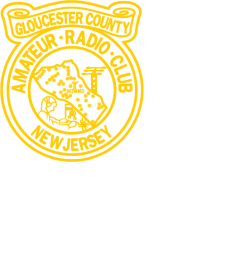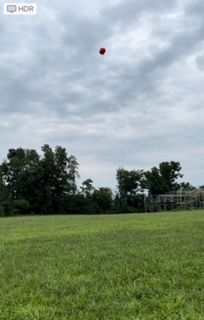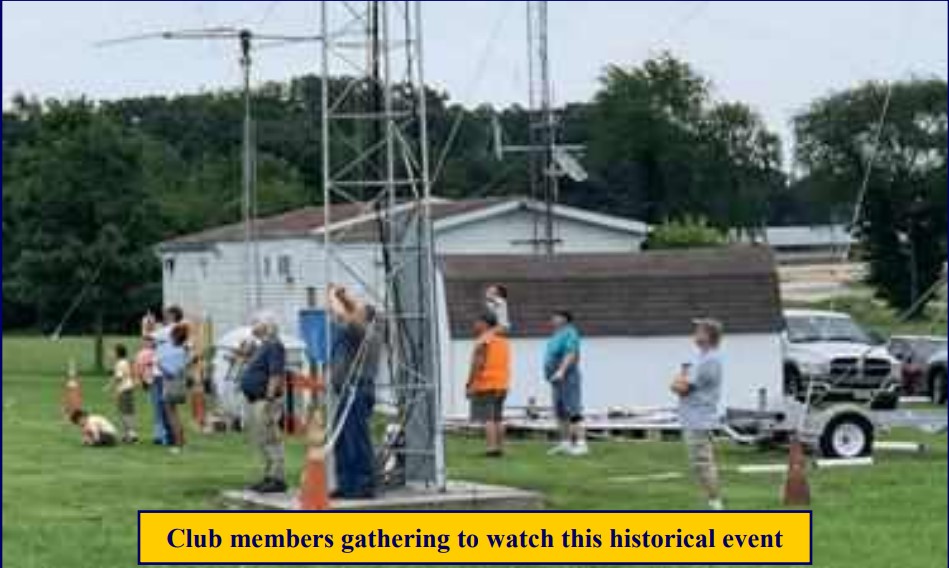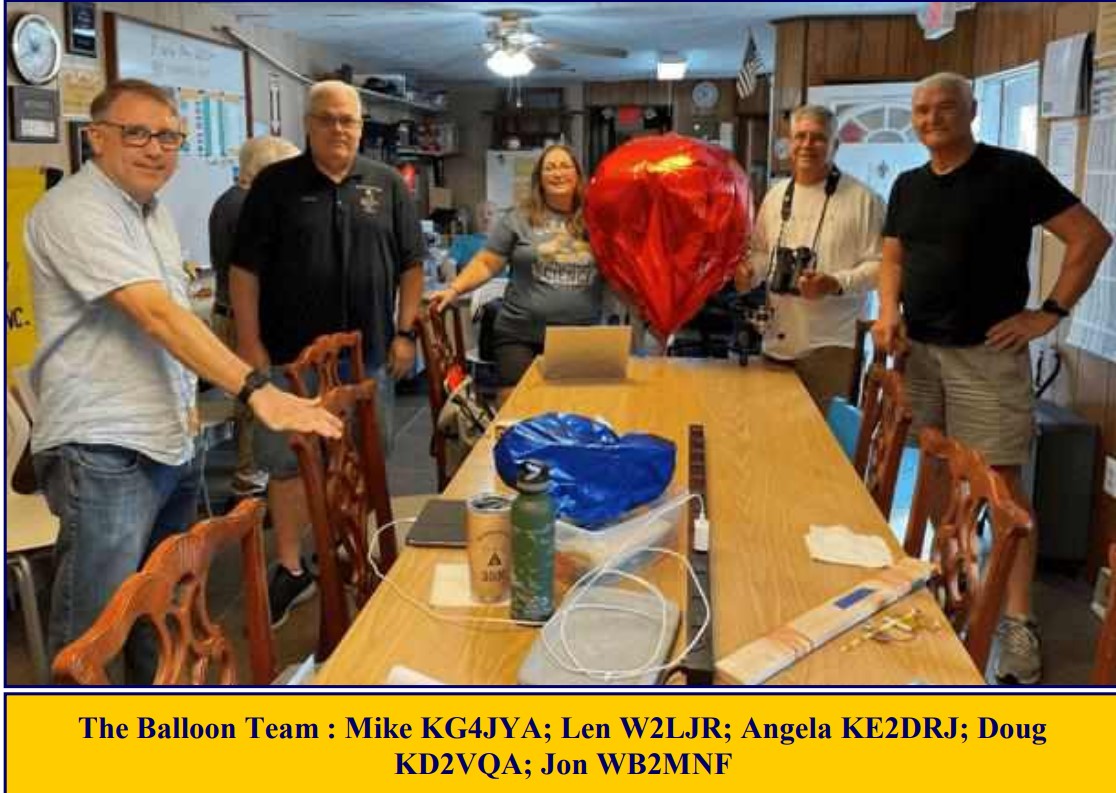
By Jon Pearce, WB2MNF1
We finally flew our first BCAR (Balloon Carrying Amateur Radio)! Here’s how that happened.
Background
As some readers might know, we were approached several months ago to develop a STEM (Science, Technology, Engineering, Mathematics) program for the Woodruff Middle School in Cumberland County. After discussions with the staff, we proposed a project involving launching high-altitude balloons carrying Amateur Radio as a core topic from which many others could be derived. Once committed to that concept, though, the Club team determined that we needed to launch one or more balloons in
advance of the beginning of the school project to develop the skills and experience needed for successful launches. We acquired many of the items needed, built a team, set up an active Discord discussion group and did lots of research. Now we were ready for the first launch.
First Flight Objective
Although our overall objective is to build a balloon that will circumnavigate the earth, we decided to take an incremental approach by setting more modest goals along the way that would allow us to use less costly materials. By substituting Mylar® party balloons for the more durable super-pressure balloons and using batteries instead of solar panels we saved significant cost, but also knew that there was no chance for a long duration flight. A shorter flight would still allow us to test many of the balloons and radio preparation steps, check out the telemetry and have some initial success. After some discussion we set a modest goal of declaring success if we could monitor the balloon up to an altitude of 10,000 feet.
Approach
The SBS balloons that we obtained for the actual launches are quite durable but also quite costly, so Doug Dersch KD2VQA picked up a few 36-inch Mylar® balloons for a few dollars that we decided to try. When completely filled with helium these balloons generated almost 150 grams of lift, so since our payload was slightly more than 50 grams, we attempted to partially fill the balloon to create this much lift and no more.
Partially inflating the balloon would allow some expansion as the balloon reached thinner air, but we also tried another approach to lessen the chance of the balloon bursting as the pressure in the balloon exceeded that of the ambient air surrounding it. In the inflation port of the balloon, we inserted a soda straw holding a small piece of a cotton mop found in the Clubhouse. We reasoned that this would allow some gas to escape from the balloon and thus would lessen its chance the bursting. In actuality that approach may have hastened its demise, as described later.
Several months ago, we purchased two balloon tracking units from ZachTek. While we still expect to use these for actual flights, we also identified a lower cost alternative that utilizes a Raspberry Pi Pico combined with an add-on board containing a GPS receiver, power converter and 20-meter transmitter known as a Jetpack. Together the cost was about $11. Mike Thompson KG4JYA figured out how to configure these devices by selecting a “channel” that defines the transmit frequency, timing, and several parameters in a spoofed call sign that allow specific identification of the WSPR packets since these devices send data that doesn’t conform to the WSPR protocol.
We decided to use a battery instead of solar cells for this launch, partly to save cost and partly because we haven’t yet decided how to fasten solar cells to this radio. An additional benefit to using batteries is that they provide a constant source of power for the radio telemetry units, meaning that we would get a telemetry update every 10 minutes. Solar cells only provide power in direct sunlight, so we might miss getting telemetry in the early stages of the launch if the balloon passed through a cloud and solar cells
flight. In the future we’ll use a smaller battery and save some weight.
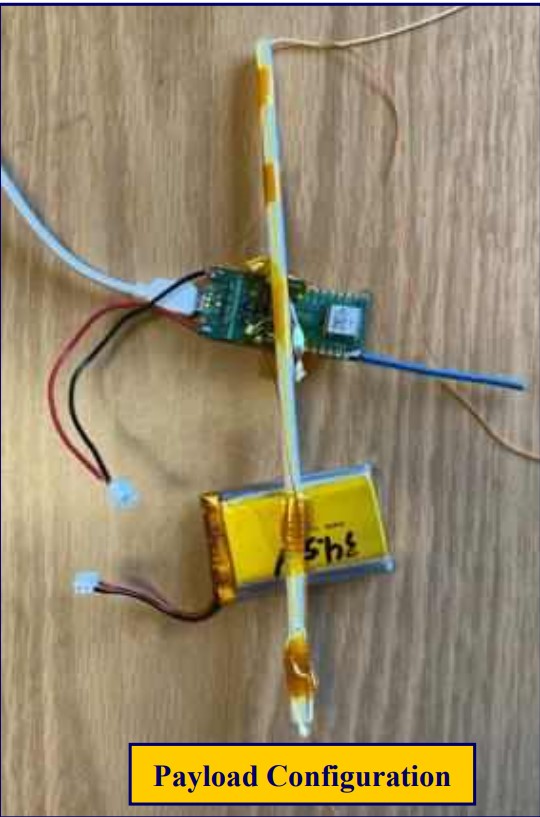
The remaining components were the wire for the vertical 20m dipole (we used the mil-spec Teflon-coated silver wire that was donated by a Club member), some Kevlar cord for strain relief, a soda straw and some Kapton tape. We taped the transmitter and the battery to the soda straw along with the antenna wire for strain relief on the solder joints to the transmitter and ran the Kevlar cord lengthwise through the straw to connect to the balloon. The antenna was wound around a wooden 1×2 with the Kevlar cord protruding from the soda straw for safekeeping during assembly. The Kevlar cord and one end of the dipole antenna are attached to the balloon with the Kaptan tape while the other end of the dipole hangs free below the transmitter.
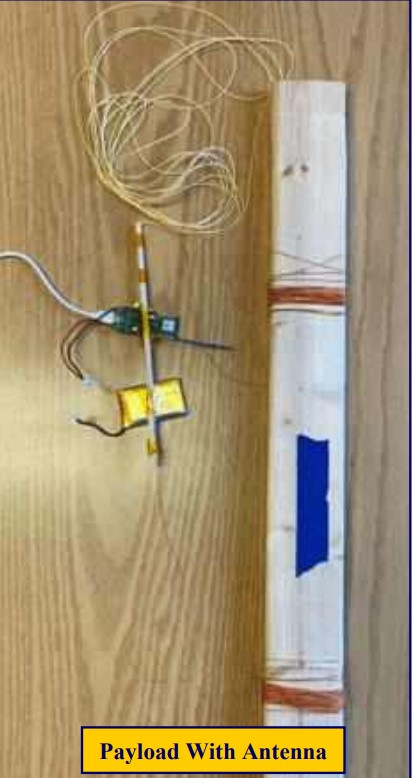
Filling the balloon with the proper amount of helium is somewhat challenging. The goal is to add enough helium to lift the weight of the payload plus an additional amount based on other experimenters’ recommendations that we established at 8 grams. Since the weight of the payload (radio, battery,
antenna, and other components) was 52 grams we decided to inflate the balloon to have 60 grams of lift. This is done by connecting a 100-gram weight to the bottom of the balloon, placing the weight on the gram scale, and inflating the balloon until the scale shows 40 grams. This is easier said than done.
The balloon needed to be filled through the soda straw which was pressed up against the inflater on the helium tank that itself needed to be bent to release the helium. This worked pretty well, but Doug
inadvertently over-inflated the balloon passed the lift point that we had identified. Since we were concerned about the balloon clearing the trees at launch we decided to leave the extra helium in the balloon. After inflation we taped the top of the Kevlar cord and the antenna to the balloon with the Kapton tape and were almost ready to go.
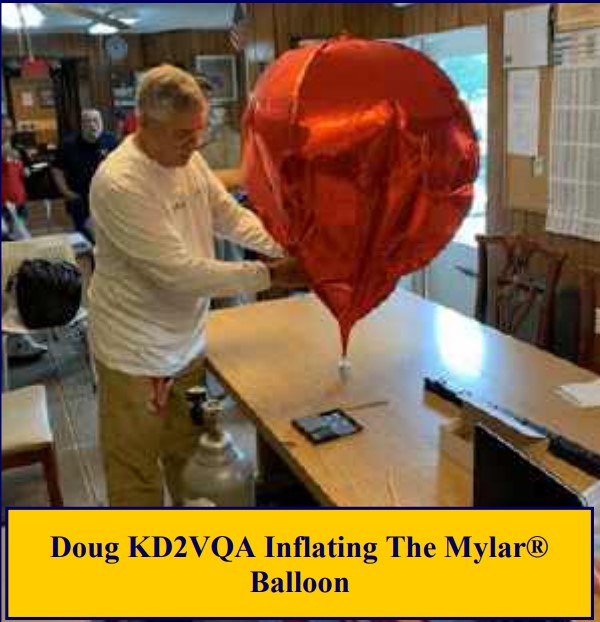
At that point we went outside and got ready for final testing and launch. Doug had brought a fishing pole with a long length of monofilament line that he looped over a knot in the Kevlar line, keeping one end of the monofilament on the fishing reel and holding the other end in his hand.
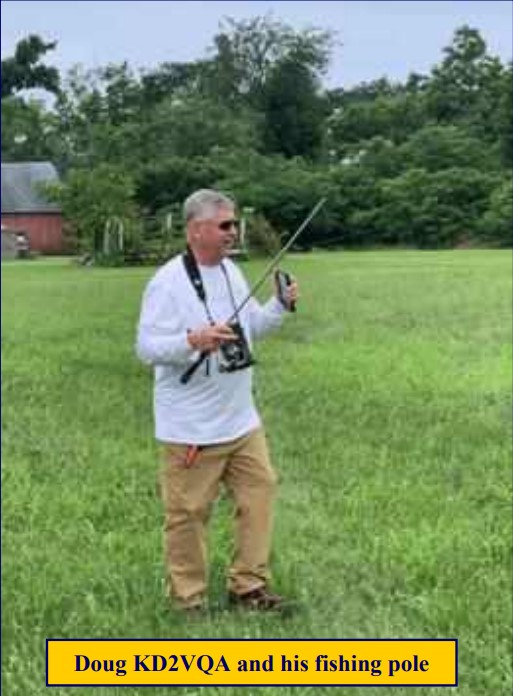
That allowed him to play out the line and see how the balloon responded to the wind, but also to reel it back in. That approach proved very helpful in precisely launching the balloon at a point when the winds were favorable. Doug unspooled the monofilament to allow the balloon to rise enough to extend the top half of the antenna for transmitter testing while Angela Metzger KE2DRJ held the bottom of the payload to keep it from moving around too much in the wind.
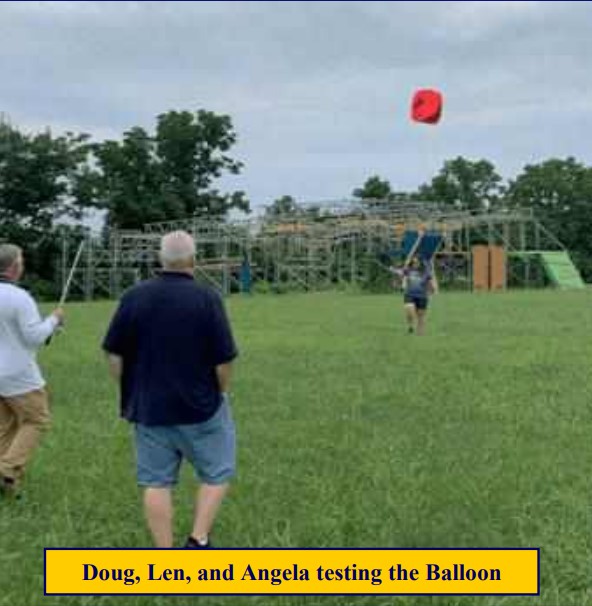
Checking The Radio
Before launching the balloon, we needed to make sure the radio was transmitting properly. The radio puts out a WSPR signal on 20 meters (14.0971 MHz), so Mike tuned in that signal on the Flex radio in the HF room and verified that it was transmitting properly. In fact our WSPR transmissions, with half of the 20 meter dipole on the ground, were still picked up worldwide! Such is a testament to the robustness of WSPR.
The Launch!
At that point we were ready to go. A moderate-sized crowd of Club members and kids had gathered over by the Clubhouse to watch the launch. Unfortunately, the wind had picked up slightly at that point and was swinging in different directions, so we held onto the balloon until it was favorable to the north, which was our furthest distance from the trees. At that point Doug asked the critical question “Clear to launch?” and in my best Gene Krantz imitation I shouted “Launch approved!”. Doug released the monofilament line and the balloon soared almost vertically and slightly to the north. We watched for several minutes until it
disappeared into the clouds and then headed into the Clubhouse to track the telemetry.
Tracking The Balloon
Inside the Clubhouse Mike was already tracking the balloon on several websites that could show various aspects of its progress. The WSPRnet site shows stations that have received WSPR transmissions from the balloon transmitter, so we could tell that the transmitter was being heard by many stations hundreds of miles away. That site didn’t tell us where the balloon was, so we primarily use the SondeHub website, which receives data from WSPRnetand was populated by a program that Mike wrote that transferred that data to SondeHub. We also use the Traquito site that showed graphical telemetry information. WSPR updates occurred about every 10 minutes, with an initial identification packet being followed by the telemetry packet, so we waited eagerly for those 10 minute updates. At first the balloon headed north almost directly towards Philadelphia International Airport but quickly turned northeast on a path that had followed through most of its journey. It slowly ascended reaching 10,000 feet after about 1/2 hour, meeting our first success criterion. As it rose, we continue to monitor the temperature, concerned that if it dropped below freezing the battery would cease to function. Although the temperature dropped to the mid 40s it remained above freezing so battery function was never a concern. The balloon continued to move northeast at about 45 mph and rising slowly until it reached almost 23,000 feet several miles east of Medford NJ. It then began to slowly descend at about the same rate that it had risen. Having far exceeded our initial goal of reaching 10,000 feet we recalibrated that goal to hope that the balloon would reach international waters before finally hitting the ocean, which we were pleased to see occurring on the balloon’s final transmission. When about 7 minutes passed with no WSPR updates we declared the mission over, but also successful. The intrepid Clubhouse team that had been hanging around for about 3 hours finally relaxed.
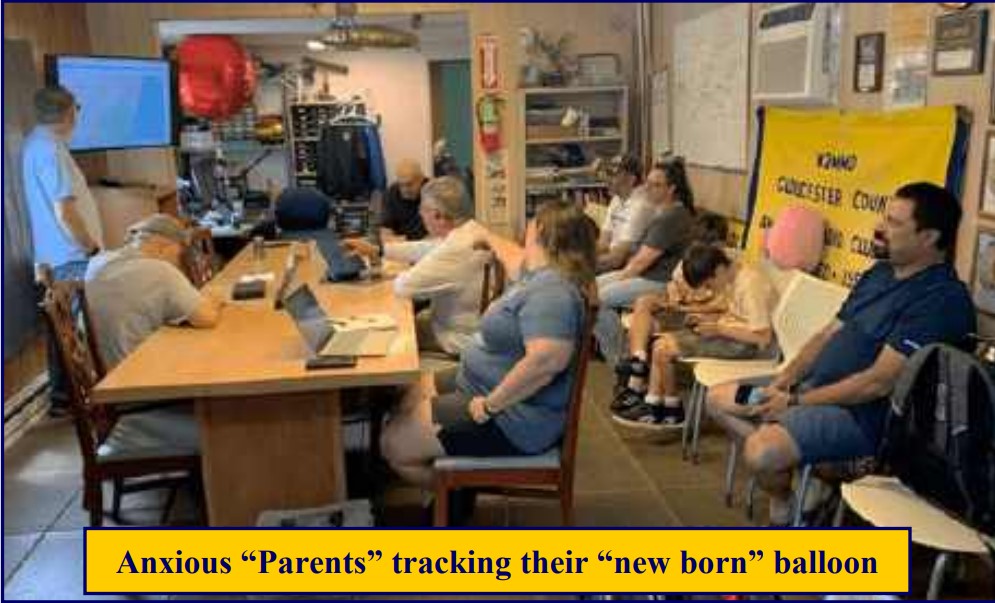
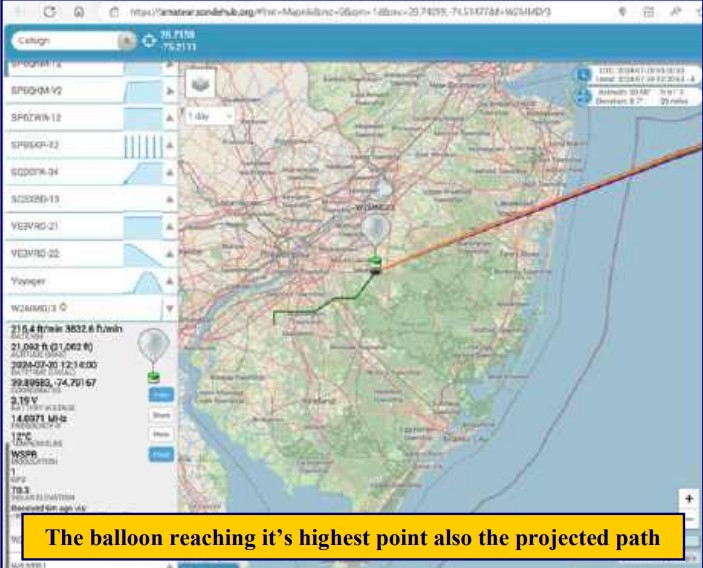
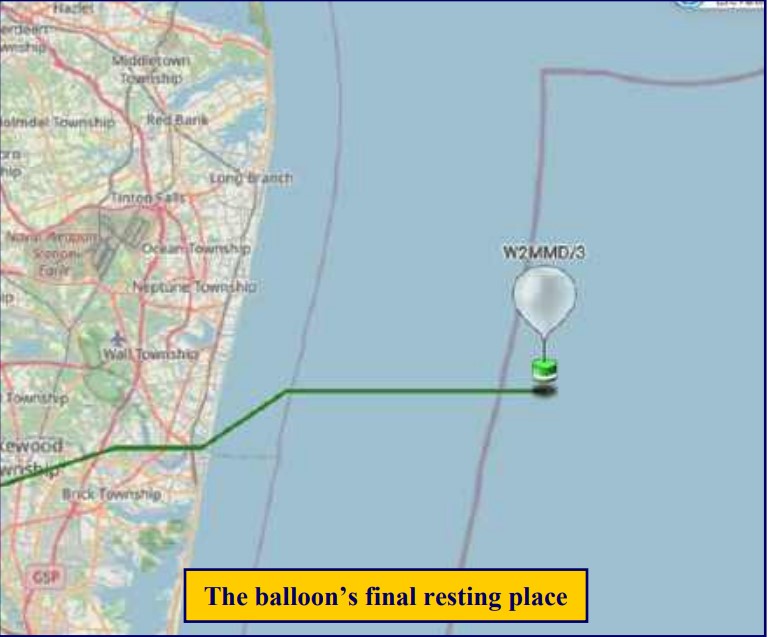
What Happened to The Balloon?
If we were SpaceX we would have had multiple sources of telemetry they could have identified the exact causes of the ultimate failure of the balloon. In particular, knowing the internal pressure of the balloon would tell us why it had descended, but here’s our best guess. Since the balloon was vented at the bottom with the soda straw to allow pressure to escape and avoid bursting we’re guessing that too much gas escaped at 22,000 feet. Without sufficient gas to continue to maintain altitude the balloon slowly descended over about 1/2 hour period. We don’t believe that the balloon burst because the descent would have been faster. And noting that we had initially over inflated the balloon the excess internal pressure of the balloon occurred at a lower altitude than if we had properly inflated it.
What’s Next?
If we’re correct in our assumptions there’s another logical test to try, which is sealing the bottom of the balloon and seeing how high it will go before it bursts. We’re going to try that sometime over the week of July 29th and may have some additional information at that point. Regardless of that outcome we plan to launch the SBS balloon on August 3rd and with the goal of achieving a successful circumnavigation of the earth.
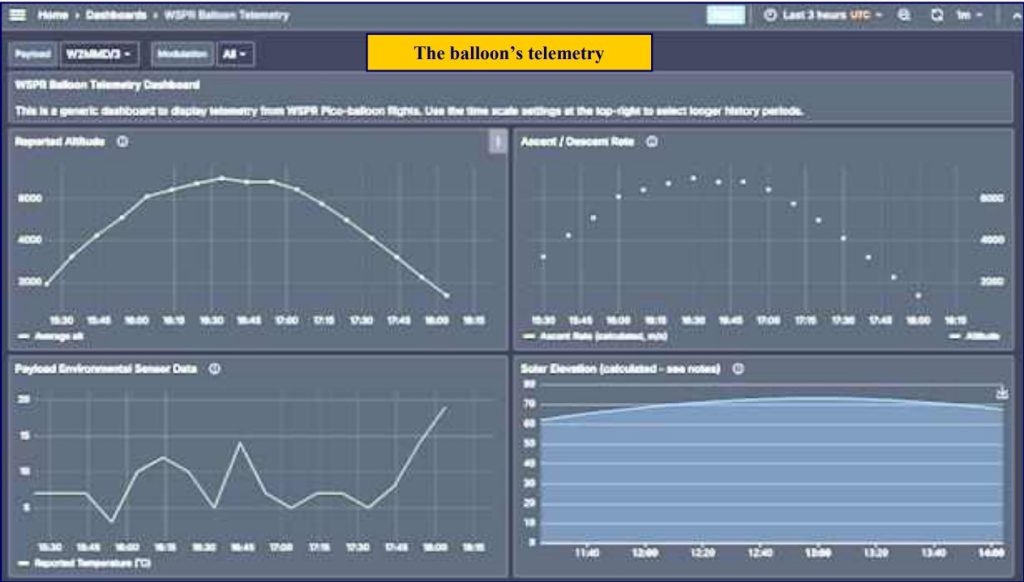
- Edited and updated by Mikke Thompson (KG4JYA) ↩︎
